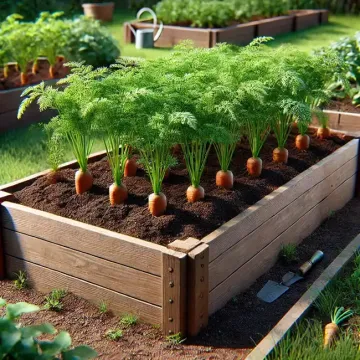Carrots are a popular and versatile root vegetable that can be a rewarding addition to any home garden. Not only are they delicious and packed with nutrients, but they are also relatively easy to grow. This article will guide you through the process of growing carrots, from selecting the right variety to harvesting the sweet, crunchy roots.
Introduction to Carrots
Carrots (Daucus carota subsp. sativus) are biennial plants in the Apiaceae family, originally cultivated for their aromatic leaves and seeds. Today, they are primarily grown for their edible taproots, which come in various colors, including the familiar orange, as well as purple, red, yellow, and white. Carrots are rich in beta-carotene, fiber, vitamin K, and antioxidants, making them a healthy choice for your homegrown vegetable collection.
Selecting the Right Carrot Variety
There are several types of carrots, each suited to different growing conditions:
- Nantes: These cylindrical carrots are sweet, crisp, and grow well in various soil types.
- Imperator: Known for their long and tapered shape, these are often the variety seen in grocery stores.
- Danvers: This variety is more tolerant of heavier soils and has a robust flavor.
- Chantenay: Shorter and broader, Chantenay carrots are excellent for rocky or clay-heavy soil.
- Purple and Yellow Carrots: These heirloom varieties offer a unique twist on traditional orange carrots, adding vibrant colors and rich flavors to your meals.
Choose a variety based on your soil type, growing conditions, and personal taste preferences.
Preparing the Soil
Carrots thrive in loose, well-drained soil free of rocks and debris. Sandy or loamy soil is ideal, as it allows the roots to grow straight and deep. Carrots do not grow well in heavy clay soils unless the soil is amended to improve its texture.
Before planting, loosen the soil to a depth of at least 12 inches. Incorporate organic matter, such as compost, to provide nutrients and improve soil structure. Avoid using high-nitrogen fertilizers, as they can cause carrots to produce excess foliage at the expense of root development.
Planting Carrots
Carrots are best grown from seeds sown directly in the garden. They can be planted as soon as the soil temperature reaches 50°F (10°C), which is typically in early spring. Successive plantings every two to three weeks will ensure a continuous harvest throughout the growing season.
- Planting Depth: Sow carrot seeds about 1/4 inch deep.
- Spacing: Space seeds 1-2 inches apart in rows that are 12-18 inches apart.
- Thinning: Once seedlings are about 2 inches tall, thin them to a final spacing of 2-3 inches to allow room for the roots to develop properly.
Carrot seeds are small and can take 2-3 weeks to germinate, so be patient. Keep the soil consistently moist during this period to encourage germination.
Watering and Care
Carrots need consistent moisture to grow properly. Water the garden regularly, especially during dry periods, to ensure that the soil remains evenly moist. Avoid overwatering, as this can lead to rot and other issues.
- Mulching: Apply a layer of mulch around the plants to retain moisture, regulate soil temperature, and suppress weeds.
- Weeding: Carrots are slow to establish, so keep the garden free of weeds that can compete for nutrients and water. Be careful when weeding around young seedlings to avoid damaging the delicate roots.
Common Pests and Diseases
Carrots are susceptible to a few common pests and diseases:
- Carrot Rust Fly: This pest lays eggs near the base of the plants, and the larvae tunnel into the roots. Use row covers to prevent infestations.
- Aphids: These small insects can be controlled with insecticidal soap or by introducing beneficial insects like ladybugs.
- Fungal Diseases: Proper spacing and good air circulation can help prevent fungal diseases such as leaf blight and root rot. Avoid overhead watering to reduce humidity around the plants.
Harvesting Carrots
Carrots are usually ready for harvest 60 to 80 days after planting, depending on the variety. You can begin harvesting when the roots are about 1/2 to 1 inch in diameter. For the sweetest flavor, allow the carrots to mature fully but avoid leaving them in the ground too long, as they may become woody.
To harvest, loosen the soil around the carrots with a garden fork and gently pull them from the ground. Brush off excess soil and store them in a cool, dry place. Carrots can be kept in the refrigerator or a root cellar for several weeks.
Tips for Growing Carrots
- Succession Planting: Plant new seeds every few weeks for a continuous harvest throughout the growing season.
- Companion Planting: Carrots grow well with onions, leeks, and radishes, which can help deter pests.
- Container Gardening: If you have limited space, carrots can also be grown in deep containers filled with loose, well-draining soil.
Growing carrots in your home garden can be a rewarding experience. With the right care and attention, you can enjoy a bountiful harvest of fresh, flavorful carrots that are far superior to store-bought varieties. Whether you're planting a traditional orange variety or experimenting with colorful heirlooms, carrots are a nutritious and delicious addition to your garden.

